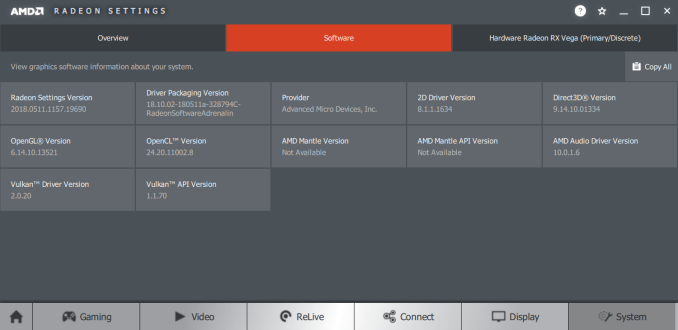AMD Releases Unified Graphics Driver for dGPUs & Desktop APUs: Radeon Software Q2 2018
by Nate Oh on May 18, 2018 10:30 PM EST
Although AMD’s Ryzen desktop APUs released back in February with the Ryzen 5 2400G and Ryzen 3 2200G, official driver support has been limited to the inaugural WHQL launch drivers for quite some time. Finally, late this week AMD has released Radeon Software Adrenalin Edition Q2 2018 WHQL, featuring support for not only the Ryzen desktop APUs but also for the Windows 10 April 2018 Update. Originally teased by AMD’s James Prior during his AMA hosted on the AnandTech forums, it also appears that this release is a unified driver for APUs and discrete GPUs.
That being said, AMD is being somewhat inconsistent about whether Adrenalin Q2 2018 is to be considered a unified graphics driver applying to discrete Radeon products. The official release notes and desktop APU drivers index indicate compatibility only with the Ryzen 5 2400G and Ryzen 3 2200G. Meanwhile, AMD has offhandedly referred to Q2 2018 package as a unified driver, and users elsewhere have reported successful installation of the driver on other APUs and discrete GPUs; the driver INF file itself shows support for a range of processors, including Carrizo, Polaris, and desktop Vega graphics. And to that end we've had no problem installing it alongside parts like the RX Vega 64.
In any case, an official 18.5.1 release might yet be pending; an Adrenalin Edition 18.5.1 release notes page remains reserved on the AMD site, while an earlier version of the Q2 2018 page referred itself as 18.5.1. As Adrenalin Q2 2018 is a WHQL certified driver with support for the Windows 10 April 2018 Update, which contrasts to 18.4.1’s beta support for the April Update, this would be a useful distinction for those who keep to WHQL packages.
Moving onto the driver itself, the documentation only notes three bugfixes:
- Destiny 2 may experience increasing load time durations when the game is run for extended periods of time.
- Tearing may be observed in some borderless fullscreen games on Radeon FreeSync enabled displays when Radeon Software performance metrics is enabled.
- Radeon ReLive streaming or uploading of videos to Facebook may intermittently fail.
Adrenalin Q2 2018 also notes a selected list of open issues:
- BSOD may be encountered when launching Radeon Settings if the system was not rebooted after driver installation.
- Workaround: Reboot the system
- Radeon Chill game specific profiles may remain applied when Radeon Chill is globally disabled.
- Some games may experience minor stuttering during gameplay when the Radeon ReLive Instant Replay feature is enabled and FRTC is also enabled.
- Radeon Settings video profiles may fail to enable for some video content on Chrome or Firefox.
- Warhammer: Vermintide 2 may experience UI flickering or disappearing on the extreme or high quality presets when using DirectX11 API.
- Radeon Overlay may not show all available features when some games are run in borderless fullscreen mode.
- The Witcher 3 may experience stuttering during gameplay.
Last week, AMD had clarified that a future WHQL-certified driver would be bringing production-ready PlayReady 3.0 support, after the release of beta PlayReady 3.0 support for Polaris GPUs in 18.4.1 (driver version 18.10.01.05). On that matter, Adrenalin Q2 2018 (driver version 18.10.02) documentation did not mention any PlayReady updates, though presumably still enables PlayReady 3.0 capability on Polaris.
The updated drivers for AMD’s desktop, mobile, and integrated GPUs are available through the Radeon Settings tab or online at the AMD driver download page. More information on these updates and further issues can be found in the Radeon Software Adrenalin Edition Q2 2018 release notes.
Related Reading
- Marrying Vega and Zen: The AMD Ryzen 5 2400G and 2200G Review
- Overclocking the AMD Ryzen APUs: Guide and Results
- Delidding the AMD Ryzen 5 2400G APU: How-To Guide and Results
- AMD Launches Ryzen Pro with Vega: Mobile APUs and Desktop APUs
- AMD 18.4.1 Driver Brings Beta PlayReady 3.0 Support for Polaris; Support for Vega GPUs & APUs Still to Come
Source: AMD











15 Comments
View All Comments
overseer - Saturday, May 19, 2018 - link
Is it my illusion or Radeon driver support did degenerate somewhat after Raja's departure?Death666Angel - Saturday, May 19, 2018 - link
Wouldn't this release showcase the exact opposite? Do you have any timelines for such releases in the past that can show me how it is worse now than then?Ket_MANIAC - Saturday, May 19, 2018 - link
He meant the lack of a proper driver for an extremely popular CPU series since February, which amounts to about 3 months now. AMD were always better than Nvidia at driver support since the Crimson days, but this move surprised me as well. They should have had stable drivers at launch.HStewart - Saturday, May 19, 2018 - link
My curious thought is how do the drivers work on my i8705G (Dell XPS 15 2in1) - most curiously I been trying to get 10 bit color to work on external - also how to direct output to AMD GPU - spec states it supports 6 monitor and HDMI 2.0 ( 10 bit color )HStewart - Saturday, May 19, 2018 - link
Above comment was meant for root level, but this forum but it here.I have always found NVidia to be best with drivers support, Of course this is only time I have try AMD drives since 80's or 90's. - Even the 8705G states Intel - it looks and acts the same as one mention in this article.
Ket_MANIAC - Saturday, May 19, 2018 - link
The intel driver is just AMD's driver with an Intel theme. They use the general desktop drivers as they have nothing in common with the APUs. They are like GPUs but just on the same die as the processor. The CPU and GPU are still different silicon. The APUs are different as both the CPU and the GPU are on the same silicon. So they need special drivers. Up until now, the APUs on both laptops and desktops were running drivers from the Windows update as there was no official driver.As for driver support, the tables have turned. AMD has the better driver support now with less crashes and bugs than Nvidia. IMO, only update drivers on Nvidia when you need to. On AMD the same applies, but they also have some significant performance upgrades with each driver, subtle, but noticeable over time.
campcreekdude - Sunday, May 20, 2018 - link
I update drivers if I buy a new released game or if I do a major Windows Update.Nvidia or AMD sames story.
Most of the time drivers already support the game before a big giant steam sale comes on.
HStewart - Sunday, May 20, 2018 - link
The cpu combination is actually two different dies - but included in special new advance processed Intel calls EMIB. The driver looks very similar to AMD interface show in this article - the odd thing it says new update drive is there.I disagree that AMD drivers are better than NVidia. I been using NVidia drivers since the early GeForce days My biggest concern with AMD drivers is support for professional applications
I like my XPS 15 2in1 and it currently running on my LG 34u88-B - and best think is that I can also use in on my bad or carry it around like tablet. The one thing I am not sure if this GPU.
Dragonstongue - Saturday, May 19, 2018 - link
the only issue I currently have using any "crimson" based driver (whatever you want to call it, is that the clock speeds do not drop properly when they should or do not go up when they should either LOL.granted am nut using newest best stuff (be damned if I pay 25-150% over MSRP for anything)
tried using first crimson all the way to 18.4.1 (the april driver) could not launch its control panel at all, and basically could not force control clock speeds for GPU because of this.
I prefer afterburner because can create multiple profiles which cannot do with wattman not via previous CCC, however, setting a clock does not force lock it either which is crap (I wish it was not this way)
I personally would rather have it "sluggish" but listen to the settings I use rather than override my settings and jump core or mem clock settings as it sees fit.
I hope at some point in the near future they have a finer grained user attentive control on the voltage-core-mem clocks for Radeon drivers.
base example, I can "force" my 7870 to 525/600 (core/mem) at .856v it actually uses less power than the lowest clock rate the card is capable of 150/300 at .836v (which is messed up, but I have tested this before) but the moment any "load" is pushed it will auto clock to 400/1200 @ .900 volts or full 3d load will try and clock up to 1050/1200 @ 1.219v (way overvolted for nothing)
Used to be able to "force" all time clock rates, but since I think it was driver sets 10 or 11 something or other can no longer do this which just sucks, makes potential ability to keep power/thermals in check a losing battle.
<3 AMD have for many years now, have not used nor will ever personally use and Ngreedia product again for many reasons, would be nice if the Radeon team added all those "little extras"
Also, EVGA is ditching DVD drivers instead will be using USB from now on...AMD and their partners should be doing this as well, might have been able to avoid purchases of 2200/2400g from needing a "bootkit" being sent out ^.^
campcreekdude - Sunday, May 20, 2018 - link
I had sticky clock issues with my 7970 and I kept creating support tickets and updating drivers until they fixed it. When its working fine another reason not to update.